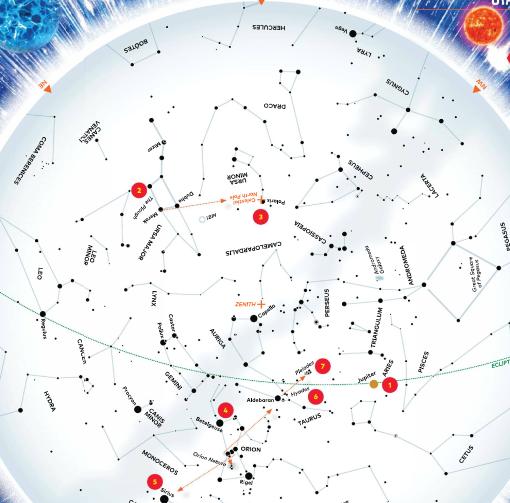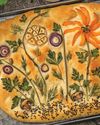
For centuries, humans have mapped the night sky, weaving patterns and stories into the heavens. These star charts reveal pathways that stargazers can follow to take a voyage across space. In February, people across the UK will be doing just that, as dark sky festivals take place up and down the country. Come with us on a tour of the night sky and discover the wonders of the cosmos.
It can get very chilly at night at this time of year, so make sure you’re dressed for the cold, with a warm coat, gloves and sturdy shoes. Step outside and find an observing spot away from the glow of street lights – be sure to ask an adult to come along if you want to go beyond your front doorstep or back garden.
When you look up, try to orient yourself on the star map (right). The map shows the whole sky as it appears around 8pm in early February (or 6pm at the end of the month). To quickly find your bearings, remember that the Sun sets in the southwest. The zenith is the point directly above your head, while the horizon forms the map’s edges. The numbers on the map mark the main stops on our tour.
Don’t worry if you can’t see much at first – your ability to see faint stars improves as your eyes get used to darkness, so try to block direct light sources (if all else fails, use an umbrella). Now, you’re all set.
1 Jupiter
This story is from the Issue 71 edition of The Week Junior Science+Nature UK.
Start your 7-day Magzter GOLD free trial to access thousands of curated premium stories, and 8,500+ magazines and newspapers.
Already a subscriber ? Sign In
This story is from the Issue 71 edition of The Week Junior Science+Nature UK.
Start your 7-day Magzter GOLD free trial to access thousands of curated premium stories, and 8,500+ magazines and newspapers.
Already a subscriber? Sign In

What happens to the ocean if we take out all the fish?
Find out about the vital role fish play in sea life.

Cleopatra's lost tomb
You told us that historical mysteries capture your imaginations, so here's an ancient Egyptian riddle.

Kate Speller
For our readers' issue, we met a zookeeper who works with big cats.

Voyager 1 turns back on
At more than 15 billion miles from Earth, the Voyager 1 spacecraft is the most distant human-made object in space.

Orangutan uses plants to heal wound
For the first time ever, a wild animal has been observed healing a wound using a plant as medicine.

Mammoth marine reptile found on UK beach
Scientists believe the ichthyosaur could be the largest ever found.

THE LAB
Three things to make and do

The brains between the sticks
Is it true that goalkeepers see the world differently?

ALIEN HUNTERS
JD Savage blasts off on an out-of-this world quest to find life beyond Earth's borders.

NATURE IN FOCUS
Join in with Science+Nature's trail at Cheltenham Science Festival.